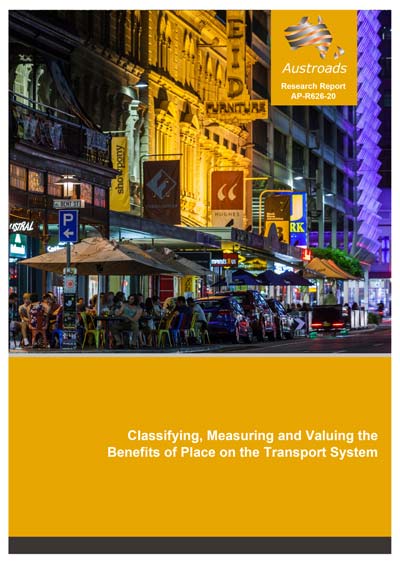Network

- Publication no: AP-R626-20
- ISBN: 978-1-922382-07-8
- Published: 17 July 2020
- PDF (free) Download
This report explores and draws together the ways in which place is classified, measured and valued from a transport perspective.
Through a literature review, the study captured the way place was being measured and valued by a range of different disciplines, organisations and regions (local and international). A series of workshops and case studies across Australia and New Zealand provided an understanding of current thinking, challenges, opportunities and threats from a practitioner and authority perspective.
These reviews found that place remains a complex and subjective concept, with varying levels of confidence and progress in the development and application of tools and approaches. Based on the reviews, this study outlines a set of points to guide the development of classification, measurement and valuation, including identifying key factors as starting points, allowing for nuance to be built up over time.
- Summary
- 1. Introduction
- 1.1 Preamble
- 1.2 Objectives of Study
- 1.3 Scope of Study
- 1.4 Method of Study
- 2. Literature Review
- 2.1 Context
- 2.2 Group 1 – Transport Practitioner Approaches
- 2.2.1 Summary Group 1 – Transport Practitioner Approaches
- 2.3 Group 2 – Urban Design/Land Use Practitioner Approaches
- 2.3.1 Summary Group 2 – Urban Design/Land Use Practitioner Approaches
- 2.4 Group 3 – Linking Place to ‘Cause’
- 2.4.1 Summary Group 3 – Linking Place to Cause
- 2.5 Group 4 – Economic/Monetary Valuations
- 2.5.1 Summary Group 4 – Economic/Monetary Valuations
- 2.6 Group 5 – Proprietary Place Measures
- 2.6.1 Summary Group 5 – Proprietary Place Measures
- 2.7 Summary of Literature Review Findings
- 3. Consultation
- 3.1 Purpose of the Consultation
- 3.2 Consultation Approach
- 3.3 Key Consultation Findings
- 3.3.1 Current Situation
- 3.3.2 Nature of Place
- 3.3.3 Validity of Measuring Place
- 3.3.4 Characteristics of Suitable Metric(s)
- 3.3.5 Potential Measures of Place
- 3.4 Implications for the Study
- 4. Case Studies
- 4.1 Purpose of the Case Studies
- 4.2 Classifying Place – Evolution of Movement and Place Classification in New South Wales
- 4.3 Classifying Place – Victoria’s Movement and Place Framework
- 4.4 Measuring Place – Modernisation of Melbourne’s Tram Network
- 4.5 Measuring Place – Commercial Place Measurement Companies (Place Score™)1F
- 4.6 Measuring Place – Commercial Place Measurement Companies (Inhabit Place™)2F
- 4.7 Valuing Place – Assessment of Place Outcomes for Canberra Light Rail (Stage 2)
- 4.8 Valuing Place – Application of Valuing Urban Realm Toolkit (VURT) to Karangahape Road (K Road), Auckland
- 4.9 Implications for the Study
- 5. Discussion and Findings
- 5.1 Introduction
- 5.2 Role of Transport Practitioners
- 5.3 Classifying Place
- 5.3.1 Step 1: Start with Land Use Zones
- 5.3.2 Step 2: Refine through Local Planning and Feedback
- 5.3.3 Summary
- 5.4 Measuring Place
- 5.4.1 Step 1: Measure People, Time and the Way they Spend that Time
- 5.4.2 Step 2: Add Nuance and Complexity to Measurement Based on Objectives
- 5.4.3 Summary
- 5.5 Valuing Place
- 5.5.1 Step 1: Derive Willingness-to-pay Valuations for Place Benefits
- 5.5.2 Summary
- 5.6 Summary and Further Research
- 5.6.1 Summary of Findings
- 5.6.2 Opportunities for Further Research
- References
